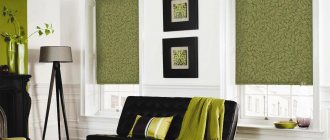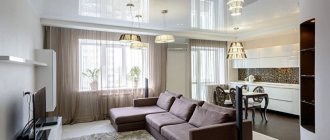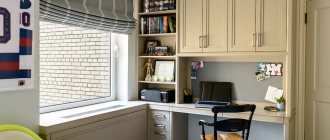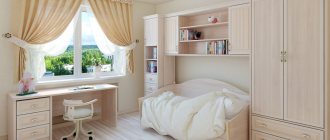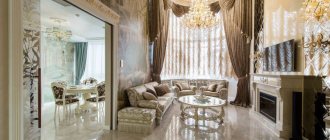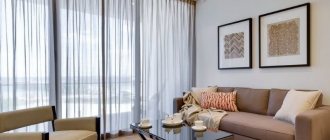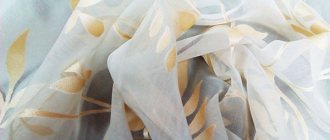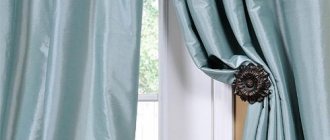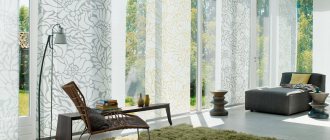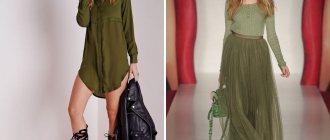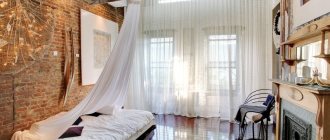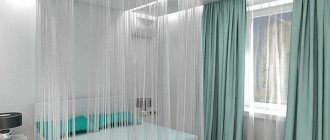Advantages and disadvantages of organza
Organza consists of natural or synthetic fibers, is weightless and durable, transmits and diffuses sunlight, and is easy to care for.
| Advantages | Description |
| Unlimited choice of colors and textures. Versatility - can be combined with any material. High level of strength due to a special technique of twisting threads in the manufacture of fabric. Resistance to fading in the sun. Light and breathability. Practicality - easy to wash and iron. | The fairly rigid texture of the fabric does not always lend itself to complex drapery. |
Material quality
Delightful fabric has a number of advantages. To the obvious lightness and beauty are added:
- strength, durability;
- good resistance to deformation;
- rigidity, retention of shape for a long time;
- unpretentiousness, ease of use;
- visual increase in space;
- affordability
- large selection of colors.
The fabric is especially valuable because you can not only purchase ready-made curtains in the store, but also sew them yourself, even for inexperienced dressmakers.
Types of curtains
Today, designers widely use various styles to decorate windows. If desired, textiles on the window can become either a soft and organic addition to the overall interior concept, or a luxurious color or texture accent of the room.
Curtains
In modern interiors, curtains are most often called curtains that are made from light and thin fabrics - organza, tulle and veil. These can also be thick, plain curtains made of smooth materials with even weaving.
Fabrics made from natural fibers with a patterned, checkered or cellular structure that are highly breathable can be an ideal option for making curtains.
The photo shows a living room in a modern style with translucent organza curtains.
Double
Double curtains are those whose fabrics are combined one on top of the other. In the decor of this type of curtains, lambrequins and a combination of two translucent curtains are often used. Multilayer curtains made of translucent organza will decorate and visually enlarge a small window.
Roman
Such curtains are made of smooth fabric, which is divided into equal sections. Each horizontal section is secured by a sewn-in strong and lightweight rod. To raise the curtain, you need to pull the cord, which is attached to the wrong side. With their help you can dim the bright daylight. And in order not to create a gloomy atmosphere, you should use translucent fabrics, such as organza.
French
This type of curtain is often called “awning”. French curtains consist of sections that are formed by semicircular folds, evenly distributed throughout the entire canvas. An awning made of silk organza or tulle goes well with lambrequins and curtains.
Austrian
The Austrian curtain is distinguished by voluminous scallops at the bottom of the canvas. At the top the curtain is draped manually or using curtain tape. These curtains are made from translucent fabrics. Depending on the purpose, it is practical to use them in the kitchen to create an airy effect and create a practical short length to the windowsill. In the living room or bedroom, paired with heavy curtains, Austrian curtains will add an accent of luxury to the interior of the room.
With photo printing
This type of curtain involves choosing any photographic image, for example a city or natural landscape, and then applying it to the canvas.
Secrets of choice
When choosing fabric for windows, you need to take into account the overall style of the room and the color of the wallpaper. If there is a pattern on the walls, then choose a plain tulle, otherwise the room will look cluttered.
Will become the highlight of your home
In stores you can find different types of organza:
- Light, transparent.
- Plain with mother of pearl.
- With gold or silver plating.
- Plain matte.
- With a “chameleon” effect (changes color).
- With colored vertical transitions.
- I'm reaping.
- With embroidered design.
- With glitter, sequins, glowing special effects.
You can choose any color to match your interior
Very often, expensive fabrics for curtains with classic patterns are made on organza. This adds lightness and airiness to the fabric . From the outside it looks as if the curls of the design are simply floating in the air.
Despite its lightness and transparency, the canvas is difficult to assemble into beautiful folds. For lambrequins it is better to use semi-organza. This is also a transparent fabric, but more matte. It is softer to the touch, easy to fold, ideal for all types of light lambrequins and elegant draperies.
Can be made from natural silk
This will be interesting to you: REVIEW: Curtains for the living room (130+ Photos): Modern ideas, models of new products for 2021 that will be remembered for a long time
Varieties of organza
Fashion trends suggest the use of new types of organza when decorating windows. Created using innovative thread weaving technologies, these types of fabrics give the effect of additional scattering of sunlight, play of color and shimmer in artificial lighting.
- Crash. This type of organza is also called “broken glass effect”. The texture of the fabric is uneven, as if cracked.
- Reaped. Or tergalet. The pattern on the fabric is similar in appearance to crash and also has a raised “crumpled” texture.
- Devore. This organza alternates dense and transparent sections of the fabric. In production, this effect is achieved by etching the fabric with specially selected reagents.
- Rain. Small dense threads are woven into the organza fabric, imitating a rain pattern.
- Chameleon. This type of fabric has an iridescent texture and silky shine.
Organza as an interior element
This fabric can and should be used not only for the design and decoration of windows; you can sew covers from it for armchairs, chairs, sofas, or use the fabric as a light curtain between rooms - this is a good alternative to doors.
In addition, decorative details are created using organza - paintings, panels, fabric napkins, stands for flower pots, wall decorations. This wonderful fabric makes interesting gift wrappings, and wedding decorations made using organza look truly fabulous! Designers love organza and use it in evening and wedding dresses, for little girls and women. This fabric often serves as an integral element of bouquets, bags, business card holders and many other accessories. Every needlewoman, looking at this amazing fabric, will have a lot of ideas on how to use it!
Dimensions
When choosing the parameters of a future curtain composition, in particular the length of the canvas, designers take into account:
- room height;
- color of walls and furniture;
- functionality of the room - living room, kitchen or bedroom.
Long
Floor-length or softly draping curtains on the floor will never go out of style. If the room is located on the south or southeast side, then long, thick curtains are suitable for protection from light. For those who love bright light, curtains made of light and light organza are suitable.
The photo shows long curtains made of brown translucent organza in combination with thick curtains.
Short
Curtains up to the length of the window sill can be used indoors for practical purposes - in the kitchen and in the nursery, to avoid frequent contamination. So it is with the aesthetics - in the design of a room with a modern style, the window frame is often decorated with short Roman blinds of dense texture. If the interior needs more light and lightness, then they are combined with airy floor-length curtains.
What is a lambrequin?
A lambrequin is a decorative cornice that is assembled from fabric and hung in front of the curtains. It hides the top curtain, creating a beautiful frame. There are many varieties of lambrequins: hard and soft, simple and complex.
Today, such finishing is used for various purposes; it can decorate an ugly cornice or the top of a curtain, or perform a stylistic function.
Most often, a lambrequin is made to match the color of the main curtain, but you can select other shades and materials that will favorably highlight the details of the interior. Most often today, organza is used for these purposes, which holds its shape perfectly. From it you can form a lambrequin with one, two, three sections, the number of folds and their appearance is not limited. The width of the lambrequins depends on the number of sections; fastening can be carried out on both sides or only on one, creating a cascading wave.
Color spectrum
A color scheme is a combination of colors and their shades that are in harmony with each other, which means they can be combined in decor and textiles when decorating an interior.
Selecting the right colors for interior design is an important task, since different shades have the ability to influence mood and physical state: some tones excite the nervous system, while others, on the contrary, calm it.
Beige
This color is an excellent base for other richer and brighter shades. In addition, the palette of beige in milky, cappuccino, ecru and caramel shades allows it to be used in a monochrome design. Designers use this method to achieve the effect of calm and softness in the interior.
White
White organza curtains have the ability to visually enlarge the space. The color white evokes positive images: the white dove is a symbol of peace and friendship. There are more than 10 shades of white, both cold and warm, for example, platinum and milky tones. Choosing the right tone will allow you to harmoniously combine the tulle with the rest of the curtain composition.
The photo shows a classic-style dining room with window decorations in the form of white translucent organza curtains.
Green
The spectrum of green shades has a beneficial effect on well-being and mood, as it is associated with living nature. In this case, you can choose soothing warm and pastel colors for the bedroom or invigorating cold and bright ones for the living room.
Black
Designers often use this achromatic shade in the interior as a stylistic accent. For example, black organza curtains are a strict and effective element in the interior of a room with light walls, a high ceiling and modern-style furniture.
Blue
This is the name of the shade of blue in the spectrum. It has a direct association with clear skies and dreams. Using this color in window decoration helps achieve the effect of lightness and harmony.
Brown
This is a shade that is not included in the spectrum of primary colors. There are more than 100 shades of brown. Designers very often combine this color with beige tones.
Pink
An easy-to-see color created by mixing red and white. Delicate shades of pink are appropriate to use in the decor of children's rooms and bedrooms.
Yellow
In the color spectrum, yellow is between orange and green, so it combines well with these colors. It can also be used independently - as a base color (at low saturation) and as an accent on the window - in a bright version.
Red
This color has a powerful stimulating effect on mood, so its use in the interior should be measured and thoughtful.
Let us list the unifying properties
Both organza and veil are light, almost weightless fabrics. By adding them to the window ensemble, you can smooth out the heaviness of the curtains and introduce notes of warmth and airiness into the interior. In addition, they have some common characteristics:
- Compound. Initially, only natural silk was used for organza, and cotton fibers were used for veils. However, recently, instead of natural ones, artificial or synthetic threads are more often used. Tulles made of polyester or viscose are no worse than natural ones in their properties;
- Drapability. As mentioned above, both materials easily form folds, which allows them to be used when sewing lambrequins and other decorative details;
- Difficult to process. Both organza and veil are difficult to cut and capricious to sew. To prevent the lightweight fabric from slipping off the table, the surface must be covered with flannel, and paper must be placed under the fabric to ensure smooth machine stitching;
- Difficulties of care. It is best to wash tulle fabrics by hand or use the most gentle machine cycle. They should be dried in the shade and away from heating devices, and ironed only through a cotton cloth, setting the iron control to the “synthetic” position.
Expert opinion
Alyona
Fabric expert and technologist Alena Khlebnikova is ready to answer your questions.
Write to us
In addition, each of the materials is painted in many colors and shades. This allows you to perfectly select tulle fabric for any room.
Styles
Interior style is a complex of distinctive properties inherent in different directions in finishing, furnishing and decorating premises.
Provence
French provincial style refers to the southern and light directions. In the interior, the use of this style creates a relaxed atmosphere of a country house.
Minimalism
The name of this style is derived from the word minimus - smallest. It accurately reflects his concept in interior and decor - conciseness, simplicity and precision.
The photo shows an interior in a minimalist style with monochrome decor on gray organza windows.
Classic
In the interior, a classic is the creation of exemplary and typical images. Namely, precise proportions, baroque or empire design of furniture and decoration. Textile design includes intricate patterns, lush draperies and expensive fabrics. The decoration uses beads, lace, curls, embroidery and gold.
Modern
When creating a modern style in a room, designers use fashion trends and experiment with finishes, colors and textures.
Convenient, easy care of curtains
Washable by hand, in a machine on a delicate cycle without spinning at a temperature of +50°C without washing powder (with low-foaming agents). Any contamination is removed after soaking for 2-4 hours.
Does not require drying or ironing; it is smoothed out under its own weight on the window. Tip: to add shine to the curtain, add 2-3 tablespoons of vinegar to the rinse water.
Curtain design
Creating a harmonious and unique decor for a window is a difficult creative task for a designer. He is required to have professionalism, accuracy of calculations and great creativity. When developing the design of curtains, it is necessary to take into account all the details, namely: the area and illumination of the room, the size and shape of the windows, the color design of the walls and the style of furniture.
- Rainbow ones. This design is especially suitable for children's rooms.
- Asymmetrical. They create a play of light and shadow and can be an original accent in a room.
- Gradient. A fashionable design with a color transition from delicate to rich shades is used in interiors with a modern style.
- With embroidery. The luxurious appearance of this decor is suitable for interiors in a classic style.
- With gold. The design using gold and silver ornaments gives the room a rich and elegant look.
- With sagging threads. A versatile and fashionable combination of organza with sagging threads is suitable for creating a bright accent in the living room, bedroom or kitchen. The sag threads can be matched to the tulle or combined in contrasting colors.
A large assortment
Among the colors, white, milky, beige, blue, and purple shades are popular. From completely transparent to canvases with multi-colored patterns that fill the entire surface.
Note!
Photos of curtains: design of curtains of different sizes and lengths. Color range, types of materials, patterns and curtain fastenings (photo + video)- Tulle design - TOP 130 photos + video reviews of tulle designs. Features of choosing fabric, length, quantity and type of tulle
Gray tulle: nuances of using gray tulle in the interior. Suitable gray fabric materials. 150 photos + video examples
Organza tulle with a pattern of white threads is suitable for the living room, nursery, kitchen, giving the room solemnity and nobility. Curtains with colored patterns will decorate any room, filling it with romanticism.
But when using canvases with patterns, you should adhere to the rule: the larger the ornament, the larger the window should be
Drawings
Curtains with patterned designs are a fashionable trend in window decoration. Curtains and wallpaper with the same pattern look especially interesting. A wide range of styles from romantic colors to strict graphic forms will help realize any creative request.
Geometry (stripe, check)
The striped design looks harmonious in interiors with a modern style.
In the photo on the left, the kitchen is decorated with bright organza curtains with a striped design.
Flowers
Among the most popular floral patterns for curtains are bright red poppies, sunny daisies, exquisite lilies and laconic sakura. In addition, the design of curtains with large flowers looks impressive, especially in spacious rooms.
Tree
Curtains with a tree pattern serve as a harmonious completion of an eco-style interior. They create a unique character for the room.
Butterflies
A pattern with butterflies on curtains is always relevant. It is often used by designers when decorating girls' rooms.
In the photo on the left is a bedroom for a girl with decor on the windows in the form of white translucent curtains with a pattern of butterflies.
Monograms
In the Middle Ages, a monogram meant writing initials with a beautiful interlacing of lines. Today this pattern is used to create decoration in the form of a complex pattern on the curtain fabric.
Origin of fabric
Tulle, used for curtains, was invented during the Regency in France. The masters were given the task of creating a light, airy veil for the king’s bride.
The fabric was woven from natural silk threads and the princess's face was reliably hidden from prying eyes. Upon closer examination, the fabric was a weave with large cells, reminiscent of a cobweb.
Photos in the interior of rooms and premises
The use of organza in various designs is unlimited and provides the opportunity to create window decor in both classic and modern styles.
Hall or living room
The effect of limitlessness in the living room is created by white organza tulle. And the curtains will be additionally decorated with a pattern, for example, a rhombus or an oval.
Kitchen
Organza kitchen curtains visually expand the space of the room and create a feeling of airiness.
The photo shows a spacious kitchen with laconic gray organza curtains.
Bedroom
Soft diffusion of light and a relaxing atmosphere in the bedroom are achieved using the translucent texture of organza.
Children's room
A calming and harmonious mood was created in the nursery using pastel shades and light organza drapery.
Alcove
The textile decor in the gazebo is aesthetically justified. Airy organza fabrics zone the space and softly diffuse sunlight.
Bathroom
Any organza color that harmonizes with the style is suitable for the bathroom.
The photo shows a classic-style bathroom decorated with white organza curtains.
Organza combined with styles
For modern styles, use matte, unpatterned curtains.
Tips for using organza products are given below:
- For high-tech, a brown tint is used.
- The minimalistic interior is complemented with white fabric.
- For Art Nouveau, the use of ornaments (floral motifs or stripes) is allowed.
- An eco-style room is complemented with organza in natural shades made from natural materials. In winter, organza is removed.
- A baroque room is decorated with a shiny variety of organza. They prefer deep shades and expensive materials.
Design ideas can be seen in the photographs.
Combination of organza curtains
Organza harmonizes perfectly with almost all types of fabrics and textures. A correctly selected palette of three or four shades will favorably emphasize the advantages of the interior.
With thread curtains
Thread curtains go well with organza. Kisey looks especially advantageous in color contrast.
The photo shows a bedroom design with original zoning with muslin and organza, contrasting in tone.
With lambrequins
Lambrequin is a short horizontal drapery invented by the French, which is located at the top of the curtain, window or doorway. This decorative element adds completeness to the textile composition.
With curtains
Almost necessary for protection from bright daylight or street lighting, laconic curtains are often combined with light and elegant organza.
The photo shows a living room with thick dark curtains and translucent organza tulle.
Combination of several colors (two or more)
A design with two-tone or multi-colored fabrics for curtains will be original and bold.
Bedroom
Lightweight material goes well with thick textured curtains. These curtains include Roman and roller curtains. It is possible to use blinds. Golden tints are suitable for the bedroom.
Organza with embroidery looks original. This option will make your interior brighter and more expressive.
Equally successful solutions include the use of taffeta or sequins. Bead patterns will make the room more expressive and significantly transform window openings.
Important! Consider the design style and the balance of the style composition.
Decorating curtains
Decorating curtains is a whole range of ways to improve their aesthetic qualities.
- Lambrequins. The use of lambrequins in window decoration adds nobility and solemnity to the entire room.
- Pickups. Creating soft folds, adding dynamics or softness to a curtain composition is possible thanks to tiebacks.
- Buffs. The voluminous decor in the form of a puff at the top of the curtain has a pompous and luxurious look.
Calculation of width for lambrequin
When deciding how to make a lambrequin, it is important to first correctly calculate the width of the fabric. The following conditions are met here:
Organza is a lightweight but at the same time rigid fabric that is difficult to process.
- If there is only one section, then the width of the fabric should be taken as the length of the cornice.
- If one section overlaps the second by about 1/3, the width is determined as follows: for each section, 3 parts are taken, for two sections - 6/3. Since the overlap length is 1/3, we get the value 6/3 - 1/3 = 5/3. Next, the resulting value is divided by 5, after which the width value multiplied by 3 is obtained.
- If 3 sections are used, then the overlap for them will be equal to: 1/3 6 9/3 - 2/3 = 7/3. The width of one section is calculated as follows: the length of the cornice is divided by 7 and multiplied by 3.
Article on the topic: Crafts for the garden from scrap materials (60 photos)
The fabric must be cut carefully, strictly following the following rules:
- The canvas should be held at an angle of 45 degrees.
- When cutting, leave allowances of 2 cm on one edge, and hems of approximately 4 cm on one side.
- The template must be secured to the fabric with needles so that it does not slip.
Mounting options for cornice
There are wall and ceiling mounting of cornices. When mounted on a wall, the cornice can be a special decorative element - with twisted tips, floral patterns or monograms.
- Eyelets. A metal or plastic sleeve installed in the fabric sheet strengthens the edges of the holes. A simple and stylish mounting method is suitable for interiors in a modern style.
- Loops. This mounting option creates a casual and fashionable window design.
- Rings. The traditional option of attaching curtains to a cornice using rings takes on a new meaning in combination with fashionable textures and drapery.
Features of work
Before you start sewing, you need to think through the design, color scheme, and method of attaching to the window. The appearance of the finished product and the ease of its use depend on this.
First select the design
Methods for attaching light curtains:
- Curtain tape. This is the most convenient option for a lush assembly.
- Eyelets are suitable for thicker fabrics.
- The loops are made of the same material as the curtain. This method of fastening is most often used in a classic or oriental style to create canopies.
Thin organza fabric is very difficult to sew.
Plain tulle matches patterned wallpaper
To make your work easier and maintain the neat appearance of the finished product, you need to:
- Cut the curtain on flannel fabric or a thin blanket. It will be almost impossible to do this on a smooth table surface.
- Double the seam allowance as the fabric frays.
- Apply water-soluble interlining to all places where the seam will go.
- The bottom and sections must be hemmed with bias tape or processed with an overlocker.
- The seam cannot be pinned.
- If you need to iron, then only through cotton fabric.
Choosing the appropriate method for attaching curtains
Recommendations for care and cleaning
Organza is easy to care for and washes easily, but in order for the fabric to retain its appearance for a long time there are several rules.
How to wash?
First of all, you need to know what mode to wash, what detergents to choose and how to bleach.
- The temperature for washing organza should be no higher than 30 degrees. The use of hot water is excluded, as the fabric is deformed.
- When washing by hand, the fabric must be soaked and not wrung out after rinsing.
- The number of revolutions should also be minimal and be a maximum of 500 per minute.
- When bleaching, you must choose gentle bleaching agents that do not contain chlorine.
How to stroke?
To avoid damaging the fabric when ironing, you must follow some rules.
- It is necessary to begin ironing organza immediately after washing, while the fabric is still damp. In this case, the smoothing process will speed up compared to dried fabric.
- Thick fabric should be placed under and on the fabric. Clean gauze is ideal for this.
- The temperature of the iron should be at a minimum, otherwise yellow or burnt spots may appear, which will spoil the appearance of the curtains.
Which is better: organza or veil
The differences between a veil and organza in a number of parameters are shown in the table.
| Parameter | Veil | Organza |
| Rigidity | Soft, airy. | Tough, prickly. |
| Compliance | Easily wrinkles and changes shape. | Keeps its shape. |
| Strength | Tights and damage often appear on the canvases. | Resistant to mechanical damage. |
| Durability | If handled properly it will last 7-10 years. | With proper care it will last 7-10 years. |
| Care | Wash with gentle detergents. Iron with care. | Machine washable. Ironing is rarely required. |
Depending on personal preferences, everyone independently determines which option suits them best.
An alternative to organza is microveil, semi-organza. These curtains combine softness and elasticity.
Models and types of lambrequins
There are 4 types of lambrequins:
Tough. An important part of modernity and postmodernism. Under the soft fabric there is a rigid frame made of plastic or wood, which holds a constant shape. They are installed under the ceiling and almost completely cover the ceiling. They do not blow away in the wind, but they cannot be washed.
It is impossible to remove the fabric from the frame, so you will have to wash it by hand
Soft. Fully woven pelmet. It can be based on both natural and synthetic materials. The cutting pattern is simple, so it is possible to make it even with your own hands. Unlike rigid models, it can be serviced. Can be washed in a machine at the appropriate temperature. Curtains with a soft lambrequin for the hall are suitable for classicism and baroque.
Openwork bandeau. Elegant curtains with an openwork lambrequin, created using laser cutting. The fundamental difference from others is versatility. They are appropriate in design, both modern or loft, and classicism. They can have a hard structure (an additional frame holding the fabric) or a soft one. Regular Velcro or textile fasteners are suitable for fastening.
Combined. They simultaneously collect soft and hard elements.
Design options for a lambrequin for the kitchen
Curtains with a lambrequin for the kitchen are selected in accordance with the style of the interior and its color scheme. Textiles can be supplemented with decorative elements - tassels, cords, etc. You can take ideas from the photos below of lambrequins for the kitchen.
Openwork
An openwork lambrequin for the kitchen is suitable for different types of interior. It can be soft (felt) or framed (with a laser pattern).
For small openings, it is better to choose small and simple designs - this way the design will look more harmonious. Wide lambrequins are suitable only for large windows - in other cases they will look massive.
The product can be either plain or colored.
Asymmetry
This design implies the presence of drapery on only one side. This will be a convenient option for small opening sizes.
With puffs
This is another solution for small windows - in particular, low or insufficiently wide. But curtain designs of this type are also suitable for large openings. The most common type of puff is a braided braid.
Fringe
Fringe on the sides can give the swags a cozy, rustic look (if the fabric is conducive to this), so this design is suitable for country style. It is also used for lambrequins made of thick fabrics (velvet, taffeta), but such textiles are usually not used in the kitchen. Canvases with fringe can also be decorated with glass beads, beads and other types of decoration.
Brushes
This design can add mischief and liveliness to the interior. It is most likely not suitable for a “static” formal interior. Brushes with unusually shaped tails will help make the design of the opening more creative.
The simplest variations
Laconic decor options suit different styles, including modern ones. This design does not overload the interior and does not create disharmony.
One of the options is a narrow lambrequin made of one-color fabric, spread over the cornice. The windows in a country-style kitchen can be decorated with curtains that are pulled together with ribbon.
If the kitchen is small in size, simple and laconic window decor will suit it best. Fixing the lambrequin to the ceiling cornice will help make it visually larger. It is better to choose designs in light colors.
Short curtains
Short curtains for the kitchen with a lambrequin are a laconic and practical way of design. It is suitable for a small opening located next to a stove, sink or other object that allows dirt to get on textiles. The short length reduces the likelihood of it getting dirty.
Arched shape
This lambrequin looks calm and cozy. It is suitable for both an interior of strict classical forms and a more relaxed one. This is a good option for small windows (including very narrow ones).
Rectangular option
This is a very simple form of decoration, and also practical. This product is easy to install and does not accumulate dust. Often such products are used in a duet with traditional curtains.
Floral print
The floral pattern is considered one of the universal ones. It can fit into almost any style (except for hard and ascetic high-tech and those close to it).
